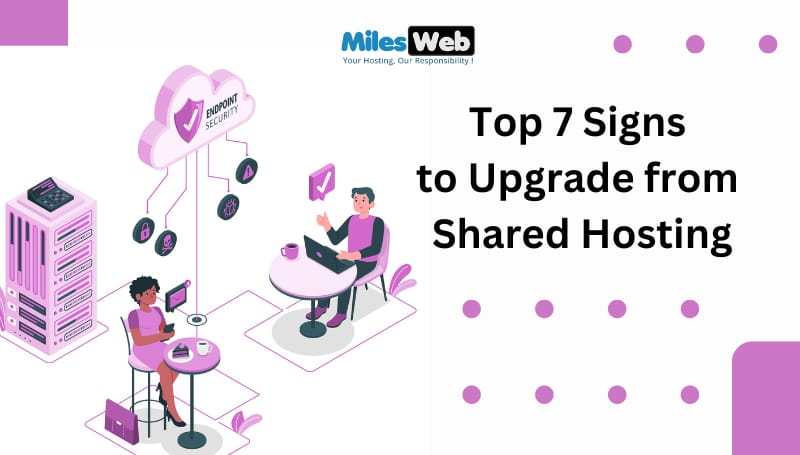Top 7 Signs to Upgrade from Shared Hosting

Hosting your website with the best plan is the dream of every website owner. Hosting plans vary in size and capability, offering various features that meet specific hosting requirements. As many website owners prefer to use the most basic web hosting services, like shared hosting, to get started, they quickly find themselves restricted by the limited resources and features.
Thus, eventually, the user needs to upgrade the cheap hosting with cpanel plan or type. Users mostly find it difficult to understand the right time to upgrade from shared hosting plans. Upgrading your shared hosting plan depends on what you’re looking to build and what you want. The motive of most websites is to build maximum online availability. And once you start getting high visitors, those shared hosting plans are less effective, limiting your growth. Therefore, finding the cheapest node js hosting could be crucial for balancing performance and cost-effectiveness as your website scales.
But worry not; in this guide, we will be giving you the top 7 signs to know that it’s time to upgrade from your shared hosting plan. So let’s begin with this insightful guide.
Is It Necessary To Upgrade My Hosting Plan?
Beginners mostly start with shared hosting solutions, as they are budget-friendly and more friendly. However, these initially are suitable and provide what you want in the beginning, but for the growing websites that get thousands of visits per day, such website hosting plans are not capable of sustaining such traffic.
In some situations, you ought to pay more to extend things like drive storage or more bandwidth to house traffic. This turns out to be quite expensive over time. When you begin to outgrow your web hosting plan, you need to upgrade your service type as well.
Top 7 Signs to Upgrade from Shared Hosting
Here comes the most-awaited part of this guide. If you face any of the below occurrences, it’s time to upgrade from your shared hosting plans and look for advanced solutions.
1. Slow speed of the website
It is common for website owners to devise unique contests, sales, etc. during holidays or other events. Even on normal days, traffic can increase as people expect websites to load quickly.
A shared server causes speed troubles as the server resources, including RAM and CPU, are shared among all sites that are on the same server. Whereas, with a VPS or a dedicated server, you get dedicated RAM, extra bandwidth, and an effective processor that boosts the page loading speeds.
2. Sudden traffic increases
Increased traffic on your website is sincerely a reason for you to be glad but if you are not organized for it, then it may be a worrisome situation. A shared web hosting plan can be sufficient for average visitors, which is under 10,000 website visitors per day.
However, if you have more visitors than this, it will likely be a smart choice to improve your plan to include cloud web hosting or VPS hosting because shared hosting can’t handle this traffic and will eventually cause downtime.
3. Customization controls
A shared hosting server has a pre-configured setup on its servers. Any website that you host on this server needs to adopt this environment and customizations can’t be carried out.
If you’re going through any situation just like this and need more customization options, then it’s time to move to an extra-controlled environment in which you get admin access and can customize the server accordingly.
4. Restricted safety features
Shared hosting has one of the most important worries: safety. The growth of your website visitors is relative to the necessity of installing advanced security features. More website visitors mean more online transactions and because of this extra revenue, there is a higher probability of data loss or breach.
With shared website hosting surroundings, there are higher probabilities of your website getting hacked as the server is shared with other websites and can be easily targeted. On a dedicated or VPS server, you get the ability to configure your firewall, anti-virus, anti-malware, and so on to ensure the robust safety of your website.
5. Excessive downtime rates
Downtime is a loss of revenue. The longer your website stays down, the more you’ll lose website visitors and, in the end, sales. If downtime is frequent, it’s time to migrate to a better web hosting provider and upgrade hosting service types.
6. Affordability Concerns
Many shared hosting providers charge extra for the additional storage, RAM, and bandwidth needed. But that’s not all. Some providers only offer basic features and advanced features are offered at additional costs.
Thus, shared hosting raises affordability concerns. Hence, it’s cheaper and less complicated to opt for advanced solutions like cloud, dedicated, or VPS servers, which are cost-effective in the long run. These services include everything from the server area to maintenance.
7. More space to grow
Another common reason to upgrade your shared server is facing problems with not having enough power to keep files, videos, pictures, and other data. The longer you hold your website, the more space it requires to grow.
Conclusion: It All Comes Down To Your Website’s Growth
A website hosting plan should be flexible and efficient enough for the expected growth of your website. While a cheap web hosting plan may sound appealing to keep costs down, in the long run, it costs more. Additionally, those limited resources and structures might harm the overall functionality of the website.
From LightSpeed and 1-click installers, it’s all about getting the fine features.
Upgrading a shared hosting plan is normally worth it to save you from further website degradation.


